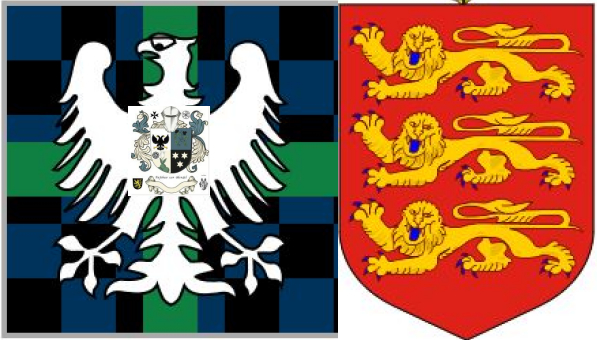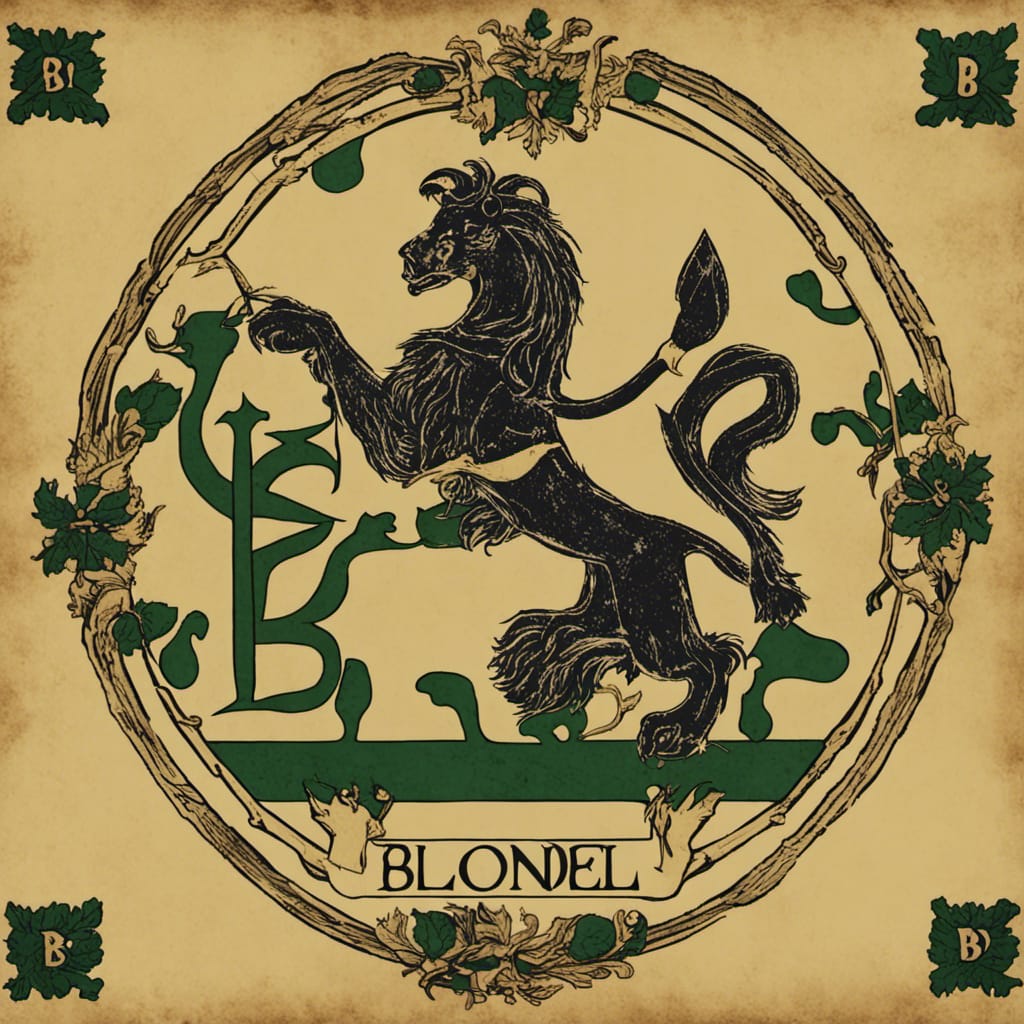


Order of the Star - Est 1022The Lord Seignuer of the Fief Blondel maintains the Chevalier Order of the Star ( Ordre de l'Étoile ) which is probably the 2nd oldest knighly order of chivalry of the Franks and Normandy. By virtue of nobility and titles being outlawed in France and the fact that the Channel Islands are part of Normandy, the Seigneur has authorized the Order of the Star to operate on the lands and shores of the Fief Blondel in Guernsey where the Feudal Laws of the Fief s and the Bailiwick of Guernsey still apply. The Seigneur of Fief Blondel is a direct descendant of William the Conqueror, the Royal Capets, Charles de Valois 1270–1325 and the De Martels of France. The Seigneur of Fief Blondel has expanded the order to 120 Knights. The Seigneur's 16th great-grandfather is Louis IX Capet de Bourbon, King of France. The Seigneur of Fief Blondel today is the Chief Captain and Baron of Annaly-Longford, Lord Baron of Ennerdale Copeland and Lord of the Liberty of Stoborough.
The Royal Eftail (or, as it is sometimes spelled, Royal Effet) of the Order of the Star (Ordre de l'Étoile) was a code of conduct that emphasized a stringent loyalty to the king, embodying an unbreakable dedication to chivalric principles. Founded in 1351 by King John II of France from the Capetian dynasty, the order aimed to strengthen the French nobility's sense of duty to the monarchy and to set a high standard of chivalric behavior. Key aspects of the Royal Eftail included:
While the Ordre de l'Étoile was short-lived, the strict Royal Eftail left a legacy in the ideals of chivalric orders that followed. The order struggled to sustain itself largely due to its rigid rules, especially the prohibition on retreat, which led to significant losses among knights in subsequent battles. Knights Prayed or Recited the 3rd Part of th Rosary which is the Glorious Mysteries. The division of the Rosary into three main sections, or sets of mysteries, in the traditional Catholic practice. Traditionally, the Rosary was divided into three parts, each containing five mysteries:
Each set represented a significant aspect of the life of Jesus and Mary, and reciting a "third part of the Rosary" referred to praying one of these sets of five mysteries. This practice was common in the medieval period when knights, along with other Christians, might have committed to reciting part of the Rosary as a devotional act, often as a form of penance, thanksgiving, or prayer for divine assistance. In 2002, Pope John Paul II introduced the Luminous Mysteries, creating a fourth set, though traditionally, the Rosary was divided into these three parts. In the traditional Catholic Rosary, the "third part" refers to the Glorious Mysteries, which focus on events celebrating the resurrection and the triumph of Jesus and Mary. The five Glorious Mysteries are:
These mysteries are traditionally prayed on Wednesdays and Sundays, as well as during the Easter season, reflecting the hope and glory central to the Christian faith. Here is the text of the third part of the Rosary, focusing on the Glorious Mysteries:
Each mystery is traditionally followed by the Our Father, ten Hail Marys, the Glory Be, and the Fatima Prayer. These Glorious Mysteries are prayed with the intention of deepening one’s faith and reflecting on the hope of eternal life. Chancellor of the Order -Commissioner Dr. George Mentz, Seigneur of Blondel has been appointed by the Patriarch as the Chancellor of the Worldwide Anglican Church of Nigeria, Ghana, Kenya and Uganda which are larger than the United States. Lord Chancellor is the top legal official of the Worldwide Anglican Church which was also known as the Ancient Orthodox Church of Africa. Mentz has been devoted to Anglican charities for decades supporting scholarships for young aspiring adults worldwide. His Lordship George Mentz has also been consecrated as a missionary Bishop for the Anglican Church. Commissioner Mentz holds a Doctor of Jurisprudence and an MBA degree from nationally accredited law schools and business schools along with a DSS Doctor of Spiritual Studies from the Emerson Institute. Mentz has also served as a White House High Commissioner in the USA fo the Presidential Scholars Programs. The Order of the Star, established in 1022, is an ancient chivalric order with a complex and rich history. It has been associated with several knightly and noble titles. Over time, the order's structure evolved, and the titles it conferred varied depending on its period of activity and the regions where it was active. However, some of the primary titles that the Order of the Star typically conferred included: 1. Knight of the Star – This was the primary rank given to members of the order. Knights were often granted the right to use the title "Sir" and were considered part of the nobility. 2. Grand Cross – The highest honor in the order, typically awarded to senior members for exceptional service or merit. Those who held the rank of Grand Cross were often seen as key figures in the order’s leadership. 3. Commander – A mid-ranking title in the order, often bestowed upon members who held command over a regional or territorial area within the order's structure. 4. Baron or Baroness – Some knights of the order, particularly those who were granted land or special privileges, were given the title of baron or baroness, conferring a certain level of territorial nobility. 5. Dame – Female members of the order, often those of noble birth or who had provided exceptional service, could hold the title of Dame. 6. Prince – In some cases, members of royal or noble families who joined the order were conferred the title of Prince within the order, recognizing their noble heritage or elevated status. The titles of Prince or Baron within the Order of the Star were typically conferred by the order’s Grand Master or other high-ranking officials within the organization. The authority to grant these titles often depended on the specific rules and hierarchy established by the order at different times in its history. In general: 1. Prince: The title of Prince was usually reserved for individuals of royal blood or high nobility. In some cases, the Grand Master of the order or a senior noble in charge of a regional or territorial area within the order might have the authority to confer this title. For example, a member of the royal family or a noble family might be elevated to the rank of Prince within the order, especially if their involvement was significant in the order's affairs or if they were taking on a leadership role. 2. Baron: The title of Baron was often granted by the Grand Master or other high-ranking officials within the order to knights or nobles who were awarded land, estates, or other forms of recognition for their service. A Baron might have been given this title due to their military or administrative role within the order, or as a reward for their loyalty, contribution, or service. Sometimes, regional commanders or those in charge of specific territories might also have the power to grant baronial titles. In both cases, the conferral of titles was typically part of a larger system of hierarchical recognition, with the higher-ranking officials of the order acting as the ultimate authority to grant such honors. Additionally, titles like Prince or Baron within the Order of the Star might have been tied to the individual's status outside the order, such as their position in the broader political or noble structure. The chief officers of the Order of the Star typically included:
These chief officers worked together to manage the organizational, military, and ceremonial aspects of the order. Over time, the specific titles and roles of the officers may have varied depending on the region and period, but the Grand Master remained the ultimate authority in the order's leadership structure. |
Seigneur de la Fief of Blondel Lord Baron Mentz of Fief Blondel Geurnsey Crown Dependency Seigneur Fief of Blondel George Mentz Lord Baron of Fiefdom Blondel Freiherr of Fief Thomas Blondel Feudal Lord of Baronnie - Noble Fief Barony Friherre > Order of the Star Est. 1022 Seigneurs and Dames Travel Research Lord Paramount Feudal Barons The Seigneur Order Patron George Mentz Charter of Liberties Deed & Title Fief Blondel Islands Viking Kingdom Fief Worship Fiefs of the Islands ECS Extended Continental Shelf Styles and Dignities Territorial Waters Blondel Privy Seal Fief Bouvees of Fief Thomas Blondel Guernsey Court of Chief Pleas Fief Court Arms Motto Flower Fief de l'Eperon La Genouinne Kingdom of West Francia Fief DuQuemin Bouvée Phlipot Pain Bouvée Torquetil Bouvée Bourgeon Bailiwick of Ennerdale Channel Island History Fief Direct from the Crown A Funny Think Happened On the Way to the Fief Guernsey Bailiwick of Guernsey - Crown Dependency Confederation des Iles Anglo-Normandes Sovereignty Papal Bull Research Links Norse Normandy Order of the Genet Order of the Genet Order of the Star Est. 1022 Knights of theThistle of Bourbon Count of Anjou Fief Rights Blondel and King Richard Press Carnival Manorial Incidents Appointments of Seigneurs Store Portelet Beach Roquaine Bay Neustrasia Columbier Dovecote Fief Blondel Merchandise Fief Blondel Beaches Islands Foreshore Events Fiefs For Sale Sold Lords of Normandy Fief Coin Viscounts de Contentin Fief Blondel Map Feudal Guernsey Titles Board of Trustees The Feudal System Hereditaments Chancellor Flag & Arms Fief Videos Guernsey Castle Sark Contact Advowson Site Map Disclaimer Freiherr Livres de perchage Lord Baron Longford Income Tax Guernsey Valliscaulian Order Saint Benedict of the Celestines Society of Divine Compassion Dictionary Count of Mortain Seigneur de Saint-Sauveur Seigneur of Fief Ansquetil Top Success Books Datuk Seri George Mentz Order St. Benedict OSB Celestines Order of the Iron Crown Order of the White Falcon Colonel Mentz Order Red Eagle Order St. Louis Order Holy Ghost Order of Saint Anthony Order of the Black Swan Order of St Columban Order of the Iron Helmet Livonian Brothers of the Sword Fief treizième and Direct from Crown Valuation Fief Blondel Prince of Annaly Teffia
Feudal Lord of the Fief Blondel of the Nordic Channel Islands Guernsey Est.
1179
Feudalherr - Fief Blondel von der Nordischen Insel Guernsey Est. 1179
New York Gazette - Magazine of Wall Street -
George Mentz -
George Mentz - Aspen Commission - Mentz Arms
Counselor George Mentz Esq. - Seigneur Feif BlondelBaron Annaly Baron Moyashel Grants to Delvin About Longford Styles and Dignities The Seigneur Court Barons Fiefs of the Islands Longford Map The Island Lords Market & Fair Fief Worship Channel Island History Fief Blondel Lord Baron Longford Fief Rights Fief Blondel Merchandise Events Blondel and King Richard Fief Coin Feudal Guernsey Titles The Feudal System Flag & Arms Castle Site Map Disclaimer Blondel Myth DictionaryMentz Scholarship Program 101 Million Donation - Order of the Genet Knighthood |





George Mentz Education -
Commissioner George Mentz
-
https://finance.yahoo.com/news/commissioner-george-mentz-clinches-influencer-180000705.html
-
George Mentz News -
George Mentz Net Worth - George Mentz Noble Tilte -
George Mentz -
George Mentz Trump Commissioner -
George Mentz Freiherren Count Baron -
George Mentz Global Economic Forum -
George Mentz Donates Millions